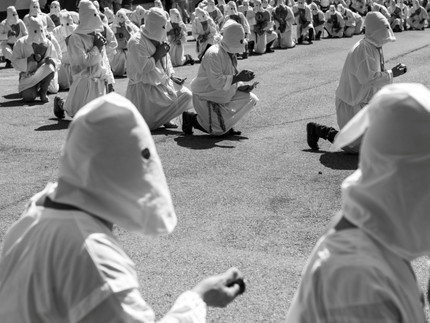Can mediatisation change the religious rites of the Assumption of the Madonna in Guardia Sanframondi?
Rita Fusco
My work is a field research on the ritual celebrations for the Assumption of Mary which take place every seven years in a small village in South Italy, Guardia Sanframondi. Here the feast of the Assumption is accompanied by the largest penitential rites in the Western world. In August 2017, around a thousand penitents walked through the village in a procession that lasted several hours, beating their chests in blood. At the Rites in the 2017, the village of about 5,000 people had more than 100,000 visitors, consisting of believers and spectators, according to the press. Although the organisers had repeatedly stressed that it was a religious celebration, the media presence was massive. Many international television crews came, including CNN, BBC and Al Jazeera team, and followed the processions. Until the Second World War, with a few exceptions, these rites were opposed by the church and state authorities as an expression of backward and superstitious popular religiosity. Today, however, the penitential character of the rites is emphasised and their value in spreading the Gospel message throughout the world has been officially recognised by the Catholic Church.
The aim of my research was to find out whether the development of media and social media has changed them. During the research, I lived for a few months in this small mountain village seventy kilometres from Naples. Afterwards, I returned regularly to Guardia Sanframondi because I wanted to understand these extraordinary rituals within the ordinary annual festive cycle.
The collective purification rite lasts for a whole week and thousands of people participate. This complex event ends with its most spectacular procession: the procession of the Battenti, which takes place on the last Sunday of the rites. The Battenti are believers who make a promise to the Madonna Assunta. They beat themselves with a penitential instrument called spugna which means 'sponge'. Such a spugna consists of a larger cork with needles stuck in it. The rites of Guardia consist of two different types of performances: the procession of the Battenti and the processions of the mysteries. For a week, until the epilogue of the procession of the Battenti, the whole village becomes the scene of religious performances. It is a set of representations in which the body plays a central role. The mysteries are reminiscent in their particularity of the mystery dramas of the Middle Ages, but unlike them, the scenes here are characterised by non-movement. The performers of the mysteries maintain the same rigid pose for the duration of the procession and in these scenes all participants remain absolutely silent. With the processions during the week, the community prepares itself for the final procession of the Battenti.
Public penitence can be considered one of the peculiarities of the rites of Guardia Sanframondi, because a penitent body is offered to the spectators during both the procession of the Battenti and the processions of the Mysteries. Without wishing to simplify, we can summarise by saying that the model of the Passion of Christ, which follows the paradigm of death and resurrection, undoubtedly places the moment of expiation at the centre of the purification rites.
In my work, I approach some of the most important thematic issues within ritual studies in this limited ethnological context: on one hand, I examine the historical transformations of ritual and its capacity for change; on the other hand, I consider aspects that continue unchanged in the present as well as those that have taken on new meaning.
My research, based on observation of the rites in Guardia Sanframondi as they are today, also included a parallel work of a historical nature. The aim of the historical work was to question and put into perspective oral traditions in which rites are often presented as something that has remained unchanged over time. The ethnological research was therefore accompanied by archival research, which allowed me to consider the rituals against the background of historical, social and cultural development.
The components of the entire event and its historical development have been the subject of extensive, long-term and multidisciplinary research led by Prof. J. Hafner. The research is now in its final phase, and new perspectives have emerged that broaden our knowledge of the Guard rituals.

